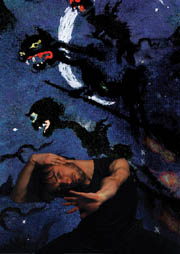
Jack Anderson
Richard Alston's Choreographic Decorum
Richard Alston Dance Company
Joyce Theater, 175 Eighth Avenue at 19th Street, Chelsea
January 12-17, 2010
Tuesday and Wednesday at 7:30 p.m.,
Thursday through Saturday at 8 p.m., Sunday
at 2 p.m.
$49, $35, $19, $10 Tickets: (212) 242-0800 or www.joyce.org
Reviewed by Jack Anderson, January 17, 2010
 |
| "SHUFFLE IT RIGHT" -- Richard Alston Dance Company (L-R) Amie Brown, Pierre Tappon. Photo by Hugo Glendinning. |
Much of Richard Alston's choreography is well-mannered. "No surprise there," some dancegoers might say. "After all, he's British." And, yes, he is. And yes, too, certain manifestations of British arts are known for their grace and decorum. In dance, the major exemplar of this sort of art is Frederick Ashton. Alston can be regarded as one of his successors. But choreographic decorum can turn into what a German critic analyzing British dance some years ago called "teacup gentility." Although Alston can seem at home among the teacups, he's also capable of spiking his choreographic tea with stronger stuff, as he tried to do, with mixed results, at the Joyce.
Music by the American song writer Hoagy Carmichael accompanied "Shuffle It Right," music that suited Alston's sensibilities. In the recordings Alston chose, Carmichael himself was the vocalist and pianist, singing with a drawl and playing with such nonchalance that some of his phrases sounded slightly blurry. Alston's dance phrases occasionally looked blurry as well, yet they weren't: they were merely understated, as Pierre Tappon and Wayne Parsons demonstrated in the opening male duet, which made them resemble a vaudeville team. Most of the time, everyone in the cast of ten danced with a low-keyed ease that was initially ingratiating, yet tended to look increasingly inconsequential as the work ambled on.
 |
| "MOVEMENTS FROM PETRSHKA" -- Richard Alston Dance Company.In Photo: Pierre Tappon. Photo by Stuart Welburn. |
Alston's dances can begin strongly, yet they also have a tendency to wander toward their conclusions. That happened in both "Shuffle It Right" and in "Blow Over," to a curious group of songs by Philip Glass that suggested the composer was trying to combine, but not very successfully, minimalist and pop styles. If there was no choreographic weak tea in the ways Alston made his cast lunge through space, often two by two, there was a sense of sameness in these progressions. Nevertheless, it was gratifying to see how Alston treated the men and women as equals in these duets.
In "Movements from Petrushka," he attempted a distillation of the central dramatic ideas of Michel Fokine's celebrated ballet to this Stravinsky score, which was played live in the composer's own piano version by Jason Ridgway, seated at the back of the stage. Liz Reed's designs incorporated fragments of Alexandre Benois's scenery for the original Diaghilev production. A program note suggested that Alston was trying to equate the unhappy puppet Petrushka with Vaslav Nijinsky, the psychologically tormented dancer who first portrayed him. Yet Tappon, as Petrushka, did little more to suggest mental distress than clutch his head as if suffering from migraine, and the people who presumably opposed him danced in clear-cut, but not especially menacing, patterns. This ballet required more than choreographic good manners from Alston.
| museums | NYTW mail | recordings | coupons | publications | classified |
